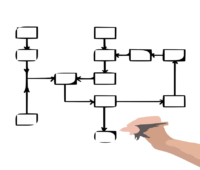Business Process Mapping Best Practices help accurately illustrate how tasks and resources are employed to transform inputs into outputs. These maps can then be used to improve business efficiency and customer interactions.
To deliver quality products or service, a business must operate efficient and effective business processes.
When a company wishes to improve its processes, business process mapping is a powerful tool that can not only identify opportunities to reduce or eliminate waste, but also reduce costs.
Furthermore, it will ensure quality products and service are delivered, resulting in improved customer experience and their overall satisfaction.
For Successful Development of a Process Map
The success of process mapping effectiveness and efficiency depends on the expertise of the process mapping practitioner, ability to ask the right questions and the type of mapping tool software employed.
To be truly successful in process mapping, certain best practices must be adopted. These are discussed in the following sections and not employing them are grave mistakes that affect the outcome map.
Business Process Mapping Best Practices – Acquiring “Buy-in” from Top Management

Acquire buy-in from all top management. This is essential for a successful exercise. There is nothing more time wasting as a senior executive who does not buy into the mapping process and consistently ensures his direct reports are engaged in other activities when they should be involved in process definition meetings.
Basic Understanding of the Business
A basic understanding of the business is a necessary foundation for any good process mapping project. Without this knowledge, certain key questions may not be asked, and you will end up with a final map not aligning with the true current state of the businesses.
Selection of the Right Process Mapping Tool
The Process mapping tool should be simple to use, and the symbols and notations easy to understand. In addition, the tool should integrate with other programs currently in use by the business. The idea is to improve processes and not create further confusion.
There is a wide variety of process mapping software programs available in the market. Sometimes it may be difficult to understand the differences between them.
However, certain businesses employ these programs for process mapping because they are cheaper compared to a professional practitioner’s fee. Furthermore, these programs are certainly beneficial for larger enterprise organizations having a large operation base.
Smaller businesses however find that the engagement of staff in the definition of processes tasks, how they can be streamlined and optimized along with well thought out opportunities for improvement is beneficial.
Firstly, it ensures the necessary “buy-in” of employees on the process mapping project, and secondly identifies opportunities for improvement.
Engaging the Right Employees to Work with The Practitioner
Business Process Mapping Best Practices – Identify a Process Owner
Identifying a Process Owner at the onset for specific processes sets the stage for accountability. Furthermore, the people with the best knowledge about a process are those who use them.
Consequently, they should be the ones engaged to work on improving the process with guidance by the practitioner.
While a VP or General Manager may have insight into the company processes, operations employees would do better justice to their own processes by readily identifying changes that could trigger unwanted steps or tasks.
The quality of the process map created will be directly correlated to the level of employee input that helped define how the process works.
Avoiding Excessive Detail in the Process Map
When there is too much detail in a process map, it becomes complicated and difficult to readily see and prioritize areas for improvement actions.
The aim of the initial process mapping exercise is to visually document the “current state” of the process or processes with the intention of identifying opportunities for improvements to document the “future state.
Consistent Use of Standard Notations and Graphics
Standardized process mapping symbols and notations must be consistently used to avoid creating confusion when reading the maps. Mapping conventions, text font, style, shape, and all other graphics should be the same.
Critical Assessment of Each Process Task
Each task within a process must be carefully reviewed and analyzed in context to all inputs and outputs. This helps to identify opportunities to improve them All opportunities should be listed in a table for review and prioritization at the end of the process mapping of the “current state”.
Applying Continuous Improvement
Once the future or desired state process map has been created, it should not be allowed to gather dust on a shelf. This can serve as a visual tool during operational audits and used for further improvements. Ideally processes and procedures should be reviewed at least once a year for effectiveness.
Conclusion
Employing Business Process Mapping Best Practices improves business process performance provides ongoing significant tangible benefits, including cost savings, increased productivity, revenue growth, improved quality, and improve customer experience.
References
Forbes 2018 What Is Customer Journey Mapping And Why Is It Important? https://www.forbes.com/sites/forbesagencycouncil/2018/11/26/what-is-customer-journey-mapping-and-why-is-it-important/?sh=4ea3b5925a76

